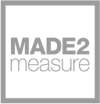How To Install A Glass Feature Wall
Step 1 - Check your wall and specification
Glass feature walls need to adhered to a wall that is flat, clean and non porous such as painted. If the wall is porous over time the glue would seep into the material and then the tiles or panels may come off the wall.
Ensure your glass is not safety backed as this will not work with glue by check that the back of your tiles or panels do not have a clear or white film applied.
Check your wall is flat and there are is bowing outwards - if this is the case you must get this remedied prior to installation.
Finally and most importantly paint your wall a dark colour such as grey. Glass tiles or panels being placed next to each other can have size deviances and therefore some may not butt perfectly together. However these can be positioned as such in a manner that it will not offend the eye. The key is to trick the eyes by hiding any small gaps as "shadow" by painting the wall a dark colour prior to installation.
Once the wall is painted/ primed you are ready to go.
Step 2 - What you need
You require a tape measure, pencil, mastic gun, mirror adhesive, stanley blade, 3mm tile spacers if concerned with expansion gaps, low modulus neutral cure silicon if wanting to seal and protect your panels from water ingress or aggressive cleaning products.
If you do not use our mirror/ glass adhesive please ensure it clearly states MIRROR ADHESIVE on the tube and do not listen to anyone else's advice as certain aggressive glues will eat the paint protecting the back of the panel - only trust the tube! If using our adhesive one tube will hang 22kgs of material onto a flat surface.
Step 3 - Installation
Installation for tiles or feature walls is best done over 2-3 days. We always recommend starting at the bottom and working upwards to avoid any chance of tiles slipping during the glueing process. The glue takes 24 hours to fully dry in ambient conditions.
So for example if you were installing a feature wall with 3 rows of tiles lengthways and 4 rows of tiles up you would lay the bottom row on day 1. Day 2 you would lay the second row using the bottom row as your baton as this row has now set dry. Day 3 you would do rows 3 and 4 using rows 2 and 3 which have set as your batons.
Place the panels in a such way that the back painted side is up and facing you.
Then place your adhesive into your mastic gun and use the stanley blade to cut the top off.
Apply lines of adhesive eveny sized and spaced about 10 cm apart across the entire face. Be careful not to go too close to the edge with the adhesive as it will smear and spread when it is applied to the wall and you do not want any seeping out a side as this would require cleaning and additional work.
Once the panel is covered with the appropriate amount of adhesive safely lift and position the panel into the desired location. The glue does not set immediately so you can manouvre the panel once its first been positioned onto the wall itself.
Once you are satisfied the panel is in the correct position, and if required is resting on a safe baton for the duration of the 24 hour drying process to stop slippage, we recommend holding the panel for at least two minutes. After two minutes the panel is safe to let go and will not come off the wall but unless resting on a baton or something sufficient it can slip a few mm down the wall during the drying process. It is difficult to advise at what weight slippage becomes a concern so we suggest you consider this and make a judegement call on site whether a baton is required or not.
If your panels require allowance for expansion gaps use the 3mm tile spacers to maintain this and you may need to increase or decrease these gaps to ensure the joins are neat depending on how accurately you measured and allowing for manufacturing tolerance.
Panels in wet areas or areas where there is potentially aggressive cleaning products being used need extra protection. Basically kitchen areas and bathrooms are areas when this additional protection is strongly advised. Simply take our neutral cure low modulus silicon and place a thin bead around the panel creating a protective membrane around the back edge of the product. Our product is clear but other colours are available online if you wanted to make this a feature. To stress the bead need only be a few mm thick but in doing this your mirror will last for years without any chance of water or bleach like cleaning products getting to attack the edges over time and thus causing potential deterioation.





